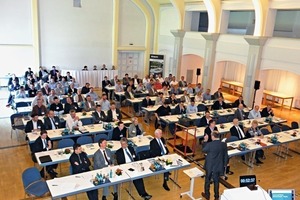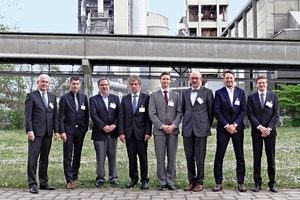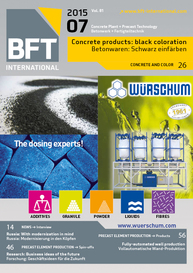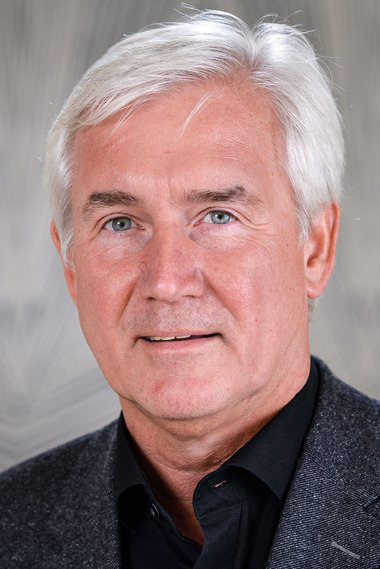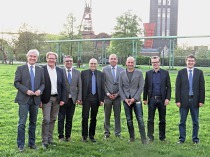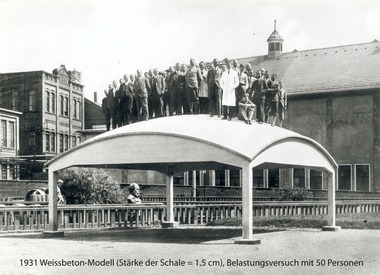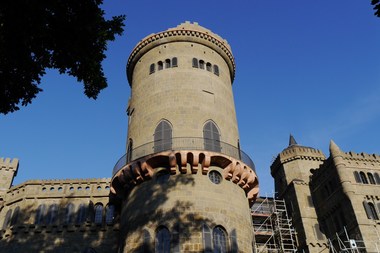Cast Stone Conference 2015: Forward-looking solutions
The topics of this year’s Dyckerhoff Weiss cast stone conference held in the German city of Wiesbaden ranged from innovative product developments in cement and concrete, modern techniques in reinforcement and formwork to the environmentally-friendly use of concrete paving blocks.
The Dyckerhoff company with its more than 150-year history had always claimed “to be nearer to the future than others”, as Dipl.-Bau-Ing. Dipl.-Wirtsch.-Ing. Martin Möllmann, Director of Dyckerhoff AG, emphasized when welcoming the about 120 guests at the information center. According to him, this was primarily due to the activities of the Wilhelm Dyckerhoff Institute (WDI), which is constantly working on seminal solutions at a high level of competence and in close cooperation with leading universities.
Innovation needs research
Under the heading “innovation needs research”, Dipl.-Ing. Thomas Deuse, responsible for product development and special building materials at Dyckerhoff GmbH, is focusing on current and trend-setting developments, both at Dyckerhoff and the parent company Buzzi. These include “Next Base”, a cement based on calcium sulfoaluminate clinker with CE marking, i.e. a so-called CSA cement as an alternative to Portland clinker, but also special cements and binders based on the ultra-fine cement technology such as Variodur and Nanodur.
Dipl.-Ing. Dennys Dressel of the technical support department at Dyckerhoff GmbH afterwards illustrated how the customers benefit from Dyckerhoff‘s continuous research and development in tangible terms. With the aid of examples he demonstrated what “customer-oriented solutions for cement and concrete” means to the Wiesbaden-based company. The speaker gave a detailed presentation of the different methods applied at WDI for simulating and testing the specific requirements and problems of the customers – using an IC tester or a laboratory block making machine, for instance.
In his presentation, Dr.-Ing. Patrick Schäffel of VDZ GmbH located in Düsseldorf dealt with the “freeze-thaw and deicing salt resistance of concrete pavers”. In his view on the “result of laboratory tests” he outlined contradictory statements regarding concrete behavior in the practical application and the testing process as well as the analysis of weather data or the influence of various deicing agents on the durability of concrete products.
Concrete and
the environment
Dipl.-Ing. Jochen Richard of the design office Richter-Richard located in Aachen and Berlin analyzed how “using different concrete paving systems can contribute to protect the environment”. From the planner‘s point of view, he primarily focused on issues such as reducing soil sealing, noise reduction and air pollution control.
What “non-metallic high-performance reinforcement can already now achieve when it comes to slender concrete components” was demonstrated by Dr. Christian Kulas of Solidan GmbH based in Albstadt. Non-corrosive bar or area reinforcement made of alkali-resistant glass, carbon and basalt allow particularly thin, lightweight and durable concrete components. They conserve resources and are already used in façade and bridge construction successfully.
The fact that, apart from material and production process, modern formwork methods “shape” concrete was outlined by Lutz Hammer of Reckli GmbH based in Herne. In particular, flexible formwork liners, so-called textured formliners, offer the possibility “to create a visual statement with concrete”. As an example: the façade of the Vorarlberg Museum in Bregenz which is decorated with more than 16,000 “concrete blossoms”.
This year’s Dyckerhoff Weiss conference was completed by a legal lecture on “current case law relating to visual defects” given by Prof. Jürgen Ulrich.

